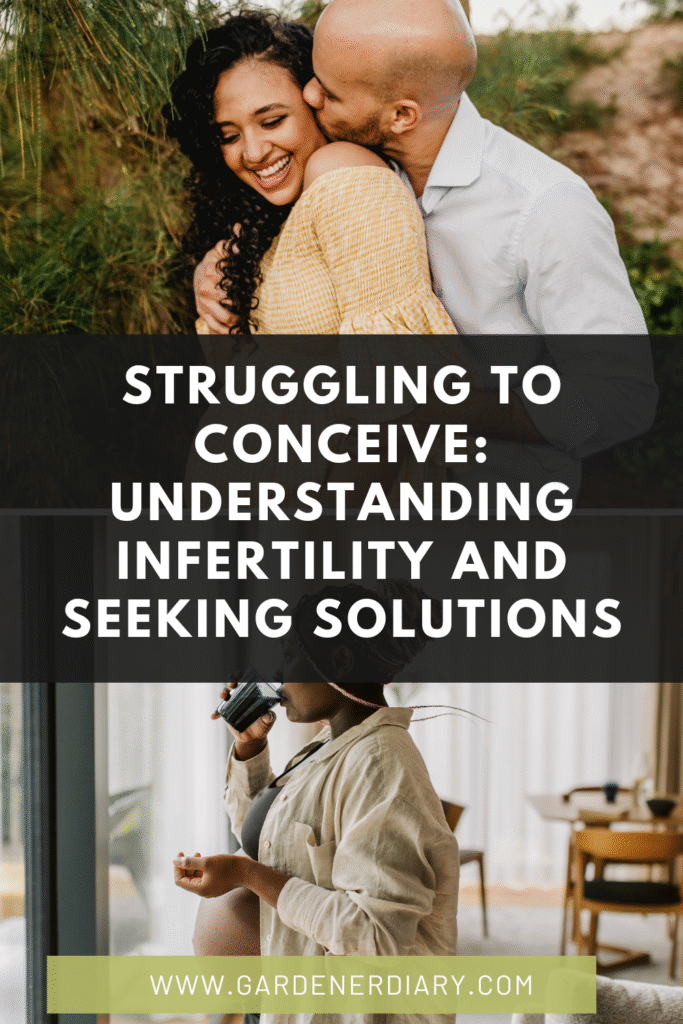Trouble Getting Pregnant: A Comprehensive Guide to Infertility Causes, Diagnosis, and Treatment
The journey to parenthood is often envisioned as a straightforward path, but for many, it can become a challenging and emotionally taxing experience. When couples find themselves facing trouble getting pregnant, it can bring about feelings of frustration, sadness, and isolation. If you’ve been trying to conceive without success, it’s important to know that you are not alone. Infertility affects millions of people worldwide, with the World Health Organization (WHO) defining it as a disease of the male or female reproductive system defined by the failure to achieve a pregnancy after 12 months or more of regular unprotected sexual intercourse. According to the WHO, infertility affects an estimated 1 in 6 people globally.
This comprehensive guide aims to shed light on the various aspects of infertility, including its common causes in both men and women, the diagnostic process, and the range of available treatment options. Understanding these factors is the first crucial step towards finding solutions and navigating your fertility journey with informed hope.
Understanding Infertility: What Does It Mean?
Infertility is generally diagnosed when a couple has been unable to conceive after:
- One year of regular, unprotected intercourse if the woman is under 35 years old.
- Six months of regular, unprotected intercourse if the woman is 35 years or older.
It’s important to remember that infertility is a medical condition, not a personal failing. It can affect anyone, regardless of their background or lifestyle. The causes can be complex, involving one partner, both partners, or sometimes remaining unexplained. For a broader medical perspective on infertility, resources like the National Center for Biotechnology Information (NCBI) provide extensive information.
Common Causes of Infertility: Female Factors
Female infertility accounts for approximately one-third of all infertility cases. The most common issues relate to ovulation, fallopian tubes, and uterine conditions.
1. Ovulation Disorders
Problems with ovulation are among the most frequent causes of female infertility. These occur when a woman either ovulates infrequently or not at all.
- Polycystic Ovary Syndrome (PCOS): A common hormonal disorder causing irregular periods, excess androgen, and often small cysts on the ovaries. PCOS can disrupt ovulation significantly.
- Hypothalamic Dysfunction: The hypothalamus, a gland in the brain, produces hormones that stimulate the ovaries. Stress, extreme exercise, or very low body weight can disrupt this function, leading to irregular or absent ovulation.
- Premature Ovarian Insufficiency (POI): Also known as premature ovarian failure, this occurs when the ovaries stop functioning normally before age 40, leading to a decline in egg production.
- Too Much Prolactin: High levels of prolactin (the hormone that stimulates breast milk production) can interfere with ovulation.
2. Fallopian Tube Damage or Blockage
Blocked or damaged fallopian tubes prevent sperm from reaching the egg or prevent the fertilized egg from reaching the uterus.
- Pelvic Inflammatory Disease (PID): An infection of the female reproductive organs, often caused by sexually transmitted infections (STIs), which can scar the fallopian tubes.
- Previous Surgery: Abdominal or pelvic surgery, including surgery for ectopic pregnancy, can cause adhesions (scar tissue) that block tubes.
- Endometriosis: A condition where tissue similar to the uterine lining grows outside the uterus, potentially causing blockages or damaging tubes.
For more detailed insights into female infertility factors, scientific journals like PMC articles on female reproductive health offer valuable research.
3. Endometriosis
Beyond tube damage, endometriosis can cause infertility in several ways, including distorting reproductive anatomy, causing inflammation, and impacting egg quality or implantation.
4. Uterine or Cervical Abnormalities
Issues with the uterus or cervix can interfere with implantation or sperm transport.
- Uterine Fibroids: Non-cancerous growths in the uterus that can block fallopian tubes or interfere with implantation.
- Uterine Polyps: Growths in the uterine lining that can also affect implantation.
- Congenital Uterine Abnormalities: Structural issues present from birth, such as a septate uterus.
- Cervical Stenosis: A narrowing of the cervix that can impede sperm from reaching the uterus.
Common Causes of Infertility: Male Factors
Male infertility accounts for approximately one-third of all infertility cases, and another third involve a combination of male and female factors.
1. Abnormal Sperm Production or Function
This is the most common male infertility issue, affecting sperm count, motility (movement), or morphology (shape).
- Low Sperm Count (Oligozoospermia): Producing too few sperm.
- Poor Sperm Motility (Asthenozoospermia): Sperm not moving efficiently.
- Abnormal Sperm Shape (Teratozoospermia): Sperm having an unusual shape, which can hinder their ability to fertilize an egg.
- No Sperm (Azoospermia): Complete absence of sperm in the ejaculate.
- Genetic Defects: Conditions like Klinefelter syndrome can affect sperm production.
2. Problems with Sperm Delivery
Even with healthy sperm, blockages or other issues can prevent them from reaching the female reproductive tract.
- Blockages: Can occur in the epididymis or vas deferens due to previous infections, surgery, or congenital defects.
- Cystic Fibrosis: A genetic disorder that can cause the vas deferens to be missing.
- Ejaculation Issues: Such as premature ejaculation or retrograde ejaculation (sperm enters the bladder).
3. Varicocele
A swelling of the veins that drain the testicle, similar to varicose veins. This can lead to overheating of the testicles, affecting sperm quality and production. It’s a common reversible cause of male infertility.
4. Hormonal Imbalances
Disruptions in the hormones produced by the pituitary gland, hypothalamus, and testicles can impact sperm production.
Other Contributing Factors to Infertility
Beyond specific medical conditions, several other factors can influence fertility in both men and women.
1. Age
Age is the most significant factor affecting female fertility. A woman’s fertility begins to decline in her early 30s and drops more sharply after 35. For men, fertility also declines with age, though typically later and more gradually.
2. Lifestyle Factors
Certain lifestyle choices can negatively impact fertility.
- Weight: Being overweight or underweight can disrupt hormone balance in both men and women, affecting ovulation and sperm quality.
- Smoking: Damages eggs and sperm, increases the risk of miscarriage, and can lead to early menopause.
- Alcohol Consumption: Excessive alcohol intake can impair fertility in both sexes.
- Stress: Chronic stress can affect hormone levels and ovulation. Managing stress through practices like mindfulness or incorporating calming routines, such as enjoying a warm cup of cinnamon tea for its benefits, can be helpful.
- Diet: A balanced diet is crucial for overall reproductive health. While not a direct cure, focusing on nutrient-rich foods can support the body’s systems. For general health and well-being, exploring the health benefits of guava or other nutritious foods can be beneficial.
- Environmental Toxins: Exposure to certain pesticides, chemicals, or heavy metals can impair fertility.
3. Medical Conditions
Underlying health issues can sometimes contribute to infertility.
- Thyroid Disorders: Both hyperthyroidism and hypothyroidism can interfere with ovulation and increase miscarriage risk.
- Celiac Disease: Untreated celiac disease can sometimes lead to fertility problems.
- Chronic Illnesses: Conditions like diabetes or kidney disease can impact reproductive health.
4. Unexplained Infertility
In about 10-20% of couples, no specific cause for infertility can be identified after a thorough evaluation. This can be particularly frustrating, but treatment options are still available.
When to Seek Help for Trouble Getting Pregnant
If you fall into the categories mentioned above (one year of trying under 35, six months over 35), it’s time to consult a healthcare provider. You should also seek earlier evaluation if you have:
- Irregular or absent periods.
- Known fertility issues (e.g., PCOS, endometriosis, previous testicular surgery).
- A history of pelvic inflammatory disease (PID) or sexually transmitted infections (STIs).
- More than one miscarriage.
Diagnosis of Infertility: What to Expect
The diagnostic process typically involves evaluating both partners to identify any underlying issues.
Female Evaluation:
- Ovulation Testing: Blood tests to check hormone levels (e.g., progesterone) to confirm ovulation, or ovulation predictor kits.
- Hysterosalpingography (HSG): An X-ray procedure to check for blockages in the fallopian tubes and abnormalities in the uterus.
- Ovarian Reserve Testing: Blood tests (FSH, AMH, Estradiol) to assess the quantity and quality of remaining eggs.
- Imaging: Ultrasound to check the uterus and ovaries for fibroids, cysts, or other structural issues.
- Laparoscopy: A minimally invasive surgical procedure to diagnose and sometimes treat conditions like endometriosis or pelvic adhesions.
Male Evaluation:
- Semen Analysis: The primary test, evaluating sperm count, motility, morphology, and semen volume.
- Hormone Testing: Blood tests to check testosterone and other hormone levels.
- Genetic Testing: If a genetic cause is suspected.
- Imaging: Ultrasound of the scrotum to check for varicoceles or other abnormalities.
Ongoing research in fertility and reproductive practice continues to refine diagnostic methods and treatment strategies, as seen in journals like Fertility Research and Practice.
Treatment Options for Infertility
Once a diagnosis is made, a personalized treatment plan can be developed. Options range from lifestyle adjustments to advanced reproductive technologies.
1. Lifestyle Changes
Addressing lifestyle factors can significantly improve fertility outcomes for some couples. This includes achieving a healthy weight, quitting smoking, reducing alcohol intake, managing stress, and adopting a balanced diet.
2. Medications
For ovulation disorders, medications can stimulate egg production.
- Clomiphene Citrate (Clomid): Stimulates ovulation.
- Letrozole (Femara): Also used to induce ovulation, particularly in women with PCOS.
- Gonadotropins: Injectable hormones that directly stimulate the ovaries to produce multiple eggs.
3. Intrauterine Insemination (IUI)
Involves placing a concentrated amount of washed sperm directly into the uterus around the time of ovulation. Often used for male factor infertility, unexplained infertility, or mild endometriosis.
4. In Vitro Fertilization (IVF)
The most effective form of assisted reproductive technology. It involves retrieving eggs from the ovaries, fertilizing them with sperm in a lab, and then transferring the resulting embryo(s) into the uterus. IVF can address a wide range of infertility causes, including blocked fallopian tubes, severe male factor infertility, and unexplained infertility. The field of IVF continues to evolve with significant advancements, as detailed in research on fertility and sterility studies.
5. Surgery
Surgical procedures can correct anatomical problems.
- For Women: Removal of fibroids, polyps, or endometriosis; opening blocked fallopian tubes.
- For Men: Repair of varicocele or surgical sperm retrieval.
6. Third-Party Reproduction
When traditional methods are not successful, options like egg donation, sperm donation, or gestational surrogacy may be considered.
Coping with the Emotional Toll of Infertility
The journey of infertility can be emotionally exhausting. It’s crucial to acknowledge and address the psychological impact.
- Seek Support: Connect with support groups, friends, family, or a therapist specializing in infertility.
- Communicate with Your Partner: Maintain open and honest communication with your partner.
- Practice Self-Care: Engage in activities that reduce stress and bring you joy. This could include hobbies, exercise, or mindfulness practices.
Conclusion: Hope and Help are Available
Experiencing trouble getting pregnant is a deeply personal and often painful challenge, but it is not a journey you have to face alone. With advancements in reproductive medicine and a growing understanding of the complex factors involved, there are more options available today than ever before.
The most important step is to seek professional medical advice from a fertility specialist. An accurate diagnosis will pave the way for a tailored treatment plan that addresses your specific needs. Remember, hope is a powerful force, and with the right support and medical guidance, many couples facing infertility are able to achieve their dream of building a family.



